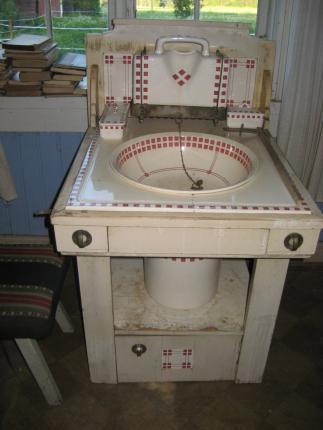Vanha kannu/vesisäiliö D.R.G.M.
Toimitusmaksu: Ei määritetty
Sulkeutuu: 1 päivä, 12 tuntia, 8 minuuttia (23 Tammi, 2026 - 12:08)
Myyjän sijainti: Suomi (Turenki)
Maksutavat: Tilisiirto, PayPal, Käteinen
Kohteen tyyppi: Huutokauppa
Tätä kohdetta on katsottu 3955 kertaa
Tietoja myyjästä
Ylläpitäjä (5)- Positiivista palautetta: (100%)
- Palautekertoja 5 kertaa
- Liittymispäivä 05 Tammi, 2010 - 12:28 Näytä aktiiviset kohteet
Kohteen kuvaus
Joo, eli kuvan mukainen löytö. Säiliö on saksalaista tekoa, josta kertoo leima D.R.G.M 260768. DRGM eli "Deutsches Reichsgebrauchsmuster" tarkoittaa, että säiliön käyttötarkoitus tai design on rekisteröity Saksassa. Leiman perusteella esineen ikä ajoittuu vuosien 1891-1952 välille.
Vesisäiliö näyttäisi kuuluvan pesukomuuttiin.
Säiliön kunto on erittäin hyvä ja säiliö sopii hienosti sisustusesineeksi.
DRGM & DRP
The acronym D.R.G.M. with or without punctuation stands for Deutsches Reichsgebrauchsmuster, meaning that the design or function of an item was officially registered inside all of the Germany states and not only locally registered as it was the case before the introduction of centralized registration. Note that many people quote this acronym as standing for Deutsches Reich Gebrauchsmuster, which is grammatically wrong and also ommits the letter 's' after Reich. This results in shifting the weight of pronounciation on 'Deutsches Reich' alone, but this acronym has nothing to do with the Third Reich as many sellers want to imply so to catch the attention of certain 'collectors'.
D.R.G.M. registration was introduced 1891 and if you are dating items you should hold in mind that even during Allied occupation up until 1949, registration procedures remained untouched and still used the D.R.G.M. registration documents, which of course explains why D.R.G.M. marks can be found on products actually manufactured up until 1952 as the registration itself was valid for three years. As from the end of October 1952, all registrations were definately marked with 'Deutsches Bundesgebrauchsmuster' (D.B.G.M.) or simply with 'Gebrauchsmuster' or 'Gebrauchsmusterschutz', see below.
As already noted, the D.R.G.M. registration offered a basic copyright protection for the duration of three years and included the right to indicate the item status by marking the registered items with the D.R.G.M. acronym. It was left to the registration owner to include the registration number as the D.R.G.M. marking alone was the element with legal character. The actual result of such a registration (the form of protection) was called Gebrauchsmusterschutz.
D.R.G.M. registered products were protected either for their way of intended use or design only and this did not include patent protection. Patent rights were secured by applying for a Deutsches Reichspatent (D.R.P.), so even if many people use the term 'D.R.G.M-Patent' it is factually wrong. Reason for this mix-up was that the D.R.G.M. registration in colloquial language was also known as 'kleines Reichspatent' which literally stands for 'small Imperial patent' but actually was meant as 'poor people's patent' and made fun of the fact that many manufacturers could not afford the fees needed to register a full patent. One should take into count that German patent registration fees (as was openly criticized during the year 1906) where two and a half times higher than in England - and 36 (!!!) times higher than in the US.
SOURCE: http://www.porcelainmarksandmore.com/resources/vocabulary/drgm.php
Pesukomuuttikuva (Designmuseo)
"Leimat vaikuttavat samoilta joita Porzellanmanufaktur Augarten Wienissä on käyttänyt. Tämä valmistaja on heti Meissenin posliinitehtaan jälkeen Euroopan toiseksi vanhin keramiikan valmistaja 8perustettu 1718). Aiemmilta nimiltään tehdas tunnetaan Porzellanfabrik Wien ja Staatsmanufaktur Wien -nimillä. Heidän leimatunnuksensa on nk. Bindenschild (vapaasti suomennettuna hirsikilpi), joka on alunperin Babenbergien ja Habsburgien käyttämä heraldinen tunnus. Samoin tehtaalla on käytetty leimattuja koristenumeroita (oletettavasti numerosarja 260768) ja massaan painettuja mallinumeroita (numerosarja 3755). Näillä tiedoilla sanoisin, että kyseessä olisi itävältalaista tuotantoa oleva pesukomuutti. "
Kysy museolta, 2014. Designmuseo vastaa [Kysy museolta www-sivulla]. Päivitetty: 24.07.2014 [Viitattu 14.02.2015]. Saatavissa:
http://kysymuseolta.fi/designmuseo/#!id=777
Maa: Suomi (14200)
Paikkakunta: Turenki
Toimitusehdot: Ostaja maksaa toimituksen, EI toimiteta kansainvälisesti
Maksutavat: Tilisiirto, PayPal, Käteinen
Aloitushinta : 20.00 EUR
Kohde alkoi: 02 Tammi, 2026 - 12:08
Kohde sulkeutuu: 23 Tammi, 2026 - 12:08
Kohteen ID: 216
